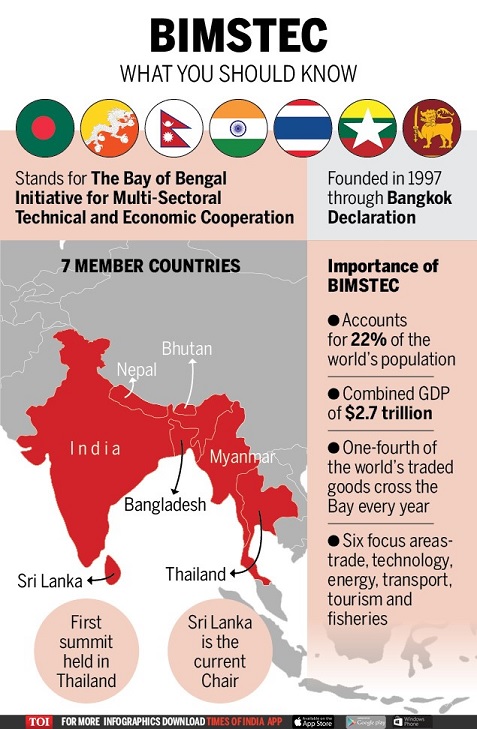Why in news?
The Bay of Bengal Initiative for Multisectoral Technical and Economic Cooperation (BIMSTEC) summit is to be held in Kathmandu.
Why is BIMSTEC significant to India?
- SAARC - A key factor is the stagnation of South Asian Association for Regional Cooperation.
- At the SAARC Summit in Kathmandu, in 2014, India proposed the SAARC Motor Vehicles Agreement.
- This could not progress due to resistance from Pakistan.
- This compelled Bangladesh, Bhutan, India, and Nepal (BBIN) to sign the BBIN Motor Vehicles Agreement in 2015.
- Pakistan also opted out of the ambitious SAARC Satellite project proposed by India.
- This led to a change in its name to the South Asia Satellite.
- Alternative - SAARC's stagnation has limited the scope of India’s growing economic aspirations.
- It has also restricted the role it could play in improving regional governance.
- These have driven India to reach out to its BIMSTEC neighbours as a viable alternative.
- But India has not stopped from revitalising the SAARC grouping when opportunities emerged.
- India’s interest in BIMSTEC is also seen as part of its strategy to isolate Pakistan.
- Power - BIMSTEC has emerged as a key vehicle to take forward India’s regional, strategic and economic interests.
- It is in India's interests to ensure that the region does not lag behind.
- BIMSTEC would be instrumental in ensuring that an unstable neighbourhood (Pakistan) does not impede growth.
- India’s desire to link South Asia to the economically dynamic Southeast Asia is also part of this strategy.
- It reassures South Asia that the region can work together, with India playing its due role.

What are the challenges?
- India is expected to face challenges from both within and outside, in terms of policy dilemmas.
- Contribution - India is currently the largest contributor to the BIMSTEC secretariat’s budget.
- Its annual contribution was Rs. 2 crore (32% of the total secretariat budget) for 2017-18.
- The secretariat plans to strengthen its capacity by increasing human resources and number of officials representing each member state.
- Given this, India may need to consider allocating more resources.
- India’s generosity would be a key test of its commitment to the sub-regional grouping.
- Supremacy - India would have to counter the impression that BIMSTEC is an India-dominated bloc.
- This is also a problem that it faced for a long time in SAARC.
- But today, many smaller neighbours are willing to engage with India to benefit from its economic rise.
- Nonetheless, for internal political reasons, the dominance issue may re-emerge and pose hurdles.
- To moderate such suspicions, India will need to show sensitivity to the concerns of smaller neighbours.
- China - China has long desired to be a part of the SAARC grouping.
- It has observer status in SAARC, which only increases demands for it membership.
- Some countries have their own interests in bringing China as they look to balance India’s dominance.
- Most of these challenges for SAARC can potentially re-emerge in BIMSTEC as well.
- So India will have to carefully handle the emerging regional geopolitics.
Source: The Hindu